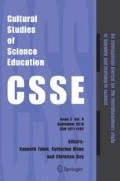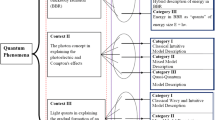Abstract
In response to the authors, I demonstrate how threshold concepts offer a means to both contextualise teaching and learning of quantum physics and help transform students into the culture of physics, and as a way to identify particularly troublesome concepts within quantum physics. By drawing parallels from my own doctoral research in another area of contemporary physics—special relativity—I highlight concepts that require an ontological change, namely a shift beyond the reality of everyday Newtonian experience such as time dilation and length contraction, as being troublesome concepts that can present barriers to learning with students often asking “is it real?”. Similarly, the domain of quantum physics requires students to move beyond “common sense” perception as it brings into sharp focus the difference between what is experienced via the sense perceptions and the mental abstraction of phenomena. And it’s this issue that highlights the important role imagery and creativity have both in quantum physics and in the evolution of physics more generally, and lies in stark contrast to the apparent mathematical focus and lack of opportunity for students to explore ontological issues evident in the authors’ research. By reflecting on the authors’ observations of a focus on mathematical formalisms and problem solving at the expense of alternative approaches, I explore the dialectic between Heisenberg’s highly mathematical approach and Schrödinger’s mechanical wave view of the atom, together with its conceptual imagery, at the heart of the evolution of quantum mechanics. In turn, I highlight the significance of imagery, imagination and intuition in quantum physics, together with the importance of adopting an epistemological pluralism—multiple ways of knowing and thinking—in physics education. Again drawing parallels with the authors’ work and my own, I identify the role thought experiments have in both quantum physics education and in physics more generally. By introducing the notion of play, I advocate adopting and celebrating multiple approaches of teaching and learning, including thought experiments, play, dialogue and a more conceptual approach inclusive of multiple forms of representation, that complements the current instructional, mathematical approach so as to provide better balance to learning, teaching and the curriculum.
Similar content being viewed by others
References
Bohm, D., & Peat, F. D. (1987). Science, order, and creativity. Toronto: Bantam Books.
Eddington, A. (1929). The nature of the physical world. New York, NY: Macmillan.
Einstein, A. (1961). Relativity: The special and the general theory (15th ed.). New York, NY: Three Rivers Press.
Epstein, L. C. (1997). Relativity visualized. San Francisco, CA: Insight Press.
Feynman, R. P. (2000). The pleasure of finding things out: The best short works of Richard P. Feynman. Harmondsworth: Allen Lane The Penguin Press.
Miller, A. (1984). Imagery in scientific thought: Creating 20th-century physics. Boston: Birkhaüser.
Miller, A. (2000). Insights of genius: Imagery and creativity in science and art (1st ed.). New York, NY: Copernicus.
Stapleton, A. J. (2003). A study of the design of interactive multimedia to improve learning of physics concepts. Doctoral thesis, Curtin University of Technology, Perth, WA.
Stapleton, A. J. (2004). Serious games: Serious opportunities. Paper presented at the AGDC 2004 ‘Playing with our minds’, Academic Summit, Melbourne Convention Centre, Victoria.
Stapleton, A. J. (2005). Research as design—Design as research. Paper presented at the DiGRA ‘05—Changing views: Worlds in Play, Vancouver, Canada.
Stapleton, A., Costello, B. M., & Ryan, M. R. (2012). Threshold concepts: Implications for game design. Paper presented at the SimTecT 2012: Simulation—Integrated solutions, Adelaide, South Australia.
Stapleton, A. J., & Taylor, P. C. (2002, July 8–11). Physics and playstation too: Learning physics with computer games. Paper presented at the Australian Institute of Physics 15th Biennial Congress, Darling Harbour, NSW.
Turkle, S., & Papert, S. (1990). Epistemological pluralism: Styles and voices within the computer culture. Signs: Journal of Women in Culture and Society, 16(1), 128–157.
Turkle, S., & Papert, S. (1991). Epistemological pluralism and the revaluation of the concrete. In I. Harel & S. Papert (Eds.), Constructionism (pp. 161–191). Norwood, NJ: Ablex Publishing Corporation.
Author information
Authors and Affiliations
Corresponding author
Additional information
Lead editor: P.C. Taylor.
This is a response paper to Anders Johannson, Staffan Andersson Minna Salminen-Karlsson, Maja Elmgren’s (2018) “Shut up and calculate”: the available discursive positions in quantum physics courses. https://doi.org/10.1007/s11422-016-9742-8.
Rights and permissions
About this article
Cite this article
Stapleton, A.J. Imagery, intuition and imagination in quantum physics education. Cult Stud of Sci Educ 13, 227–233 (2018). https://doi.org/10.1007/s11422-018-9864-2
Received:
Accepted:
Published:
Issue Date:
DOI: https://doi.org/10.1007/s11422-018-9864-2




